68% of hiring managers say at least one of their direct reports has asked for a raise or threatened to quit their job over a pay discrepancy with a new hire in the past 12 months.
Facing a disruptive labor shortage coupled with the highest inflation in 40 years, companies have had little choice in 2022 but to raise their starting offers to new hires. This “new hire premium” solves at least one problem: filling important job openings. But this solution is also creating a whole new problem, as tenured employees grow frustrated over making less money than new hires with similar skills and experience.
To better understand this phenomenon, Capterra's 2022 New Hire Premium Survey[*] surveyed 654 hiring managers and 635 staff-level workers at U.S. companies. Below, we’ll analyze the results of our survey, and offer advice to HR executives and other company leaders on how to navigate this tricky talent management situation.
Key findings
Most companies are increasing new hire pay: 65% of hiring managers say starting salaries and wages at their organization are higher than usual right now due to inflation and talent shortages. These hiring managers say new hire pay is 9% higher than usual, on average.
Nearly half of employees are aware that new hires are making more money: 45% of staff-level employees think that new hire pay at their job is higher than usual due to inflation and talent shortage. Employees who believe pay is higher estimate new hires are making 7.7% more, on average.
Companies are auditing pay more frequently, but aren’t keen on meeting raise demands: 72% of hiring managers at organizations paying new hires more say that their org has done compensation audits more frequently to identify pay discrepancies between employees. However, only 34% of employees who asked for a raise due to a perceived pay discrepancy with a new hire say they received the full amount they requested.
Frustrated employees are threatening to work elsewhere: 68% of hiring managers say at least one of their direct reports has asked for a raise or threatened to quit their job over a pay discrepancy with a new hire in the past 12 months.
A majority of companies are paying a premium for new talent
With three million fewer Americans in the labor force today compared to pre-COVID and the number of job openings remaining near record highs, the labor market was already not working in companies’ favor.
Add high inflation to the mix, and employers have found themselves needing to spend more to hire talent. In our survey, nearly two out of three hiring managers (65%) say that their organization is currently offering new employees higher starting salaries and wages than usual to combat inflation and labor shortages.
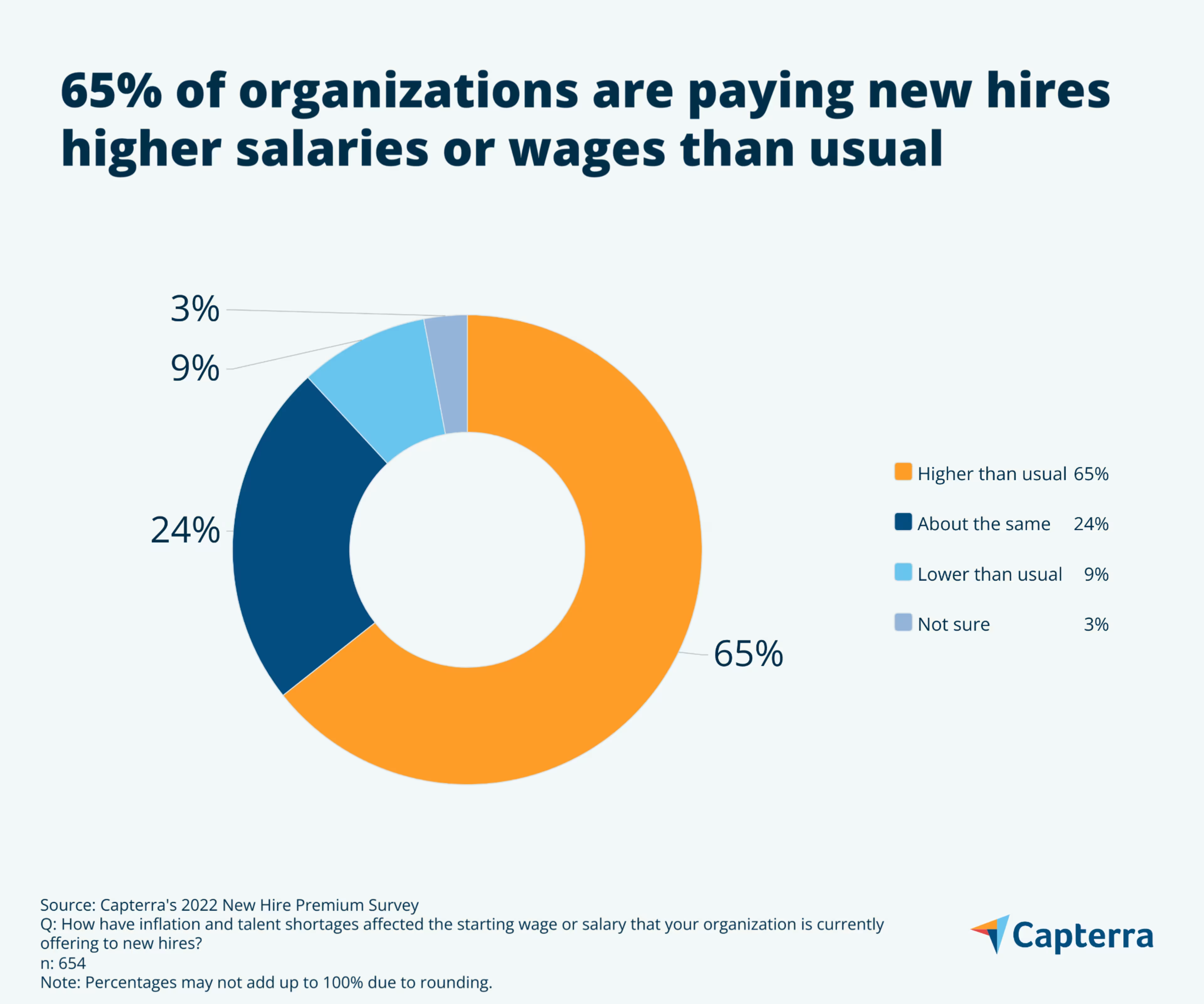
Hiring managers at organizations that have raised starting salaries or wages have done so by nine percent, on average, but close to one in six (16%) have gone as far as raising them by 15% or more.
Of the industries represented by at least 30 responses in our survey, we find that construction firms are least likely to have increased new hire pay (50%) while IT services and software companies are the most likely to have increased new hire pay (74%).
And while the likelihood of businesses increasing new hire pay remains relatively consistent across business sizes, we find that the larger the business, the more they’re willing to pay. Companies with 100 employees or fewer who have raised new hire pay did so by an average of 8.8%, compared to 10.3% at those with more than 5,000 employees.
What you need to know: The decision to raise new hire pay is a no-brainer if you’ve been desperate to fill important roles. The difficult labor market has made this necessary. However, you could be putting the wheels in motion for compensation conflicts with current employees down the line.
Current employees are aware that new hires are getting paid more
In the past, if employers wanted to, they could easily increase new hire pay and leave current employees none the wiser. But in 2022, three factors are making it much harder for companies to hide pay discrepancies from employees than before:
Normally back-page news, the recent historic shifts in labor supply and demand have made headlines, and made employees more aware of their increased worth in the current economy.
Websites like Glassdoor and Payscale give employees more information than ever before about how much money they should be making for their skills and experience in their local area.
Discussing pay at work isn’t as taboo as it once was: Only one in three employees in our survey say they never discuss and compare how much money they’re making with co-workers.
As a result, employees today are far more aware of the fact that new hires at their company are more than likely making more money right now.
When asked how they think inflation and talent shortages have affected the starting wage or salary their employer is offering to new hires, 45% of staff-level employees think that they’re higher than usual (34% think they’re about the same, and 20% think they’re lower). When employees who believe pay is higher were then asked how much they think new hire pay has been raised, the average estimate came out to 7.7%.
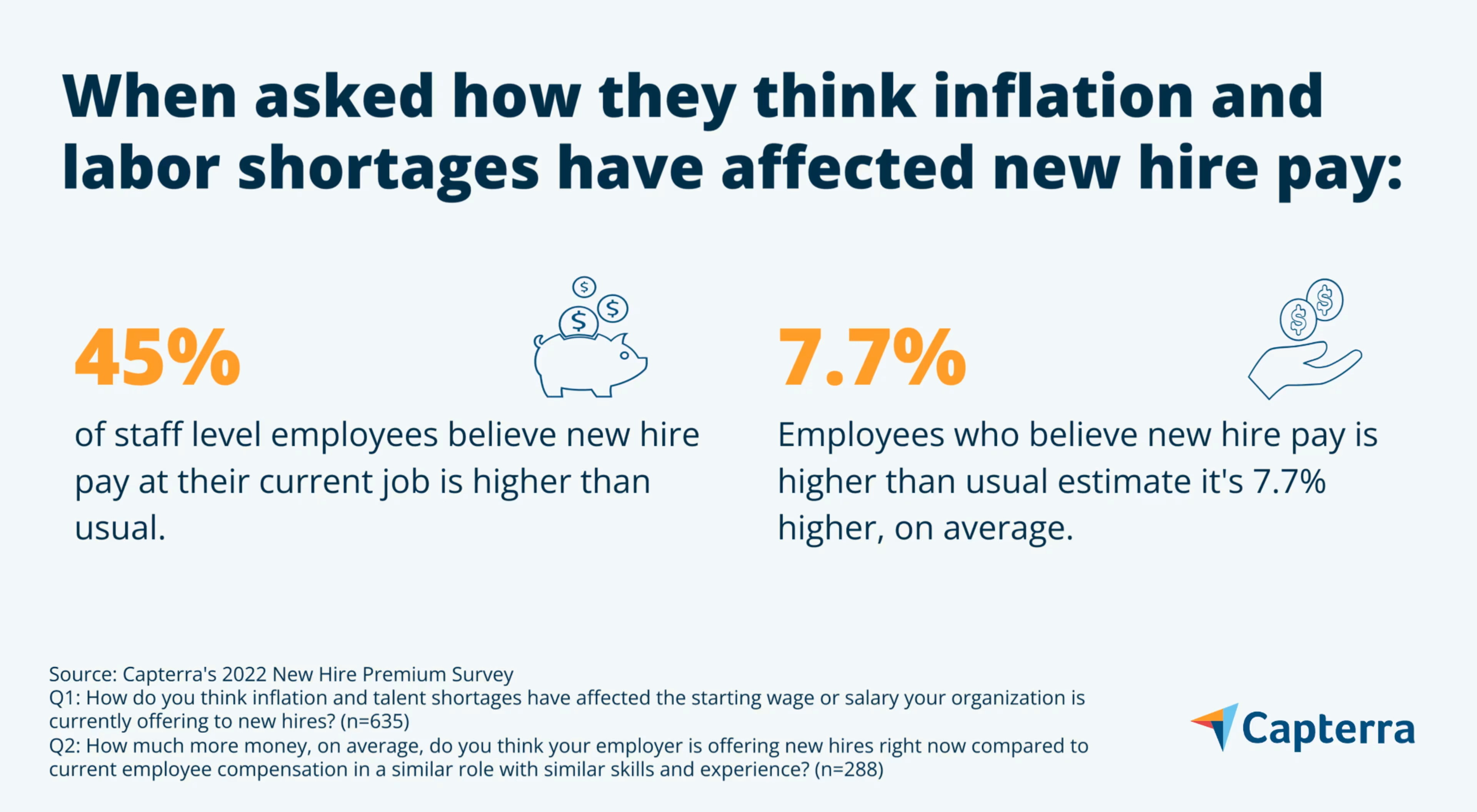
Though staff-level employees in our survey are underestimating the effect of the new hire premium compared to the actual numbers reported by hiring managers, awareness of the situation is still widespread enough that employers should be prepared for some potentially difficult conversations with tenured workers about pay.
What you need to know: Your employees aren’t blind to the fact that the price for labor is going up. You should assume that any increase in starting wages or salaries is going to be discovered by at least some employees, who may ask for more money to address any perceived discrepancies.
Companies are auditing employee pay more frequently, but employees don’t always get the raise they ask for to address discrepancies
New hire pay is up, and workers know it. The potential for conflict over pay is there. However, at the same time that companies are paying more for new talent, they’re also taking steps to ensure compensation remains fair across the organization. Of the hiring managers in our survey who indicated their organization has increased new hire pay, 72% say their organization is also auditing compensation more frequently to identify pay discrepancies between employees.
This proactive strategy is paying off, as organizations that are doing audits more often are also more frequently identifying discrepancies and handing out raises to current employees to fix them.
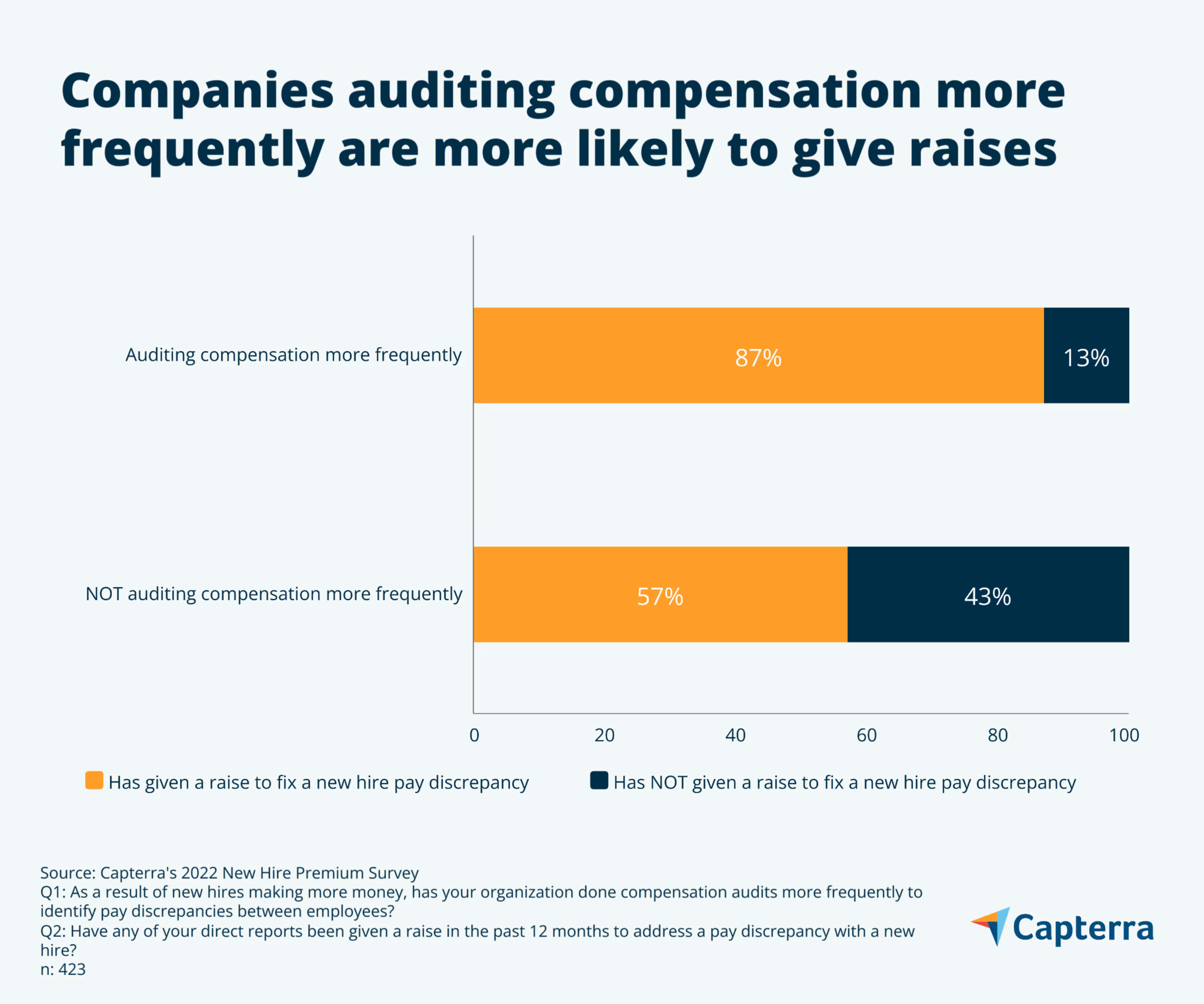
On the other hand, when employees are the ones raising the flag on pay discrepancies, employers aren’t as eager to act. Of the 23% of staff-level employees who have asked for a raise in the past 12 months because of a perceived pay discrepancy between them and a new hire, only 34% say they received the full amount they asked for. Thirty-six percent received less than they asked for, and 30% received no raise at all.
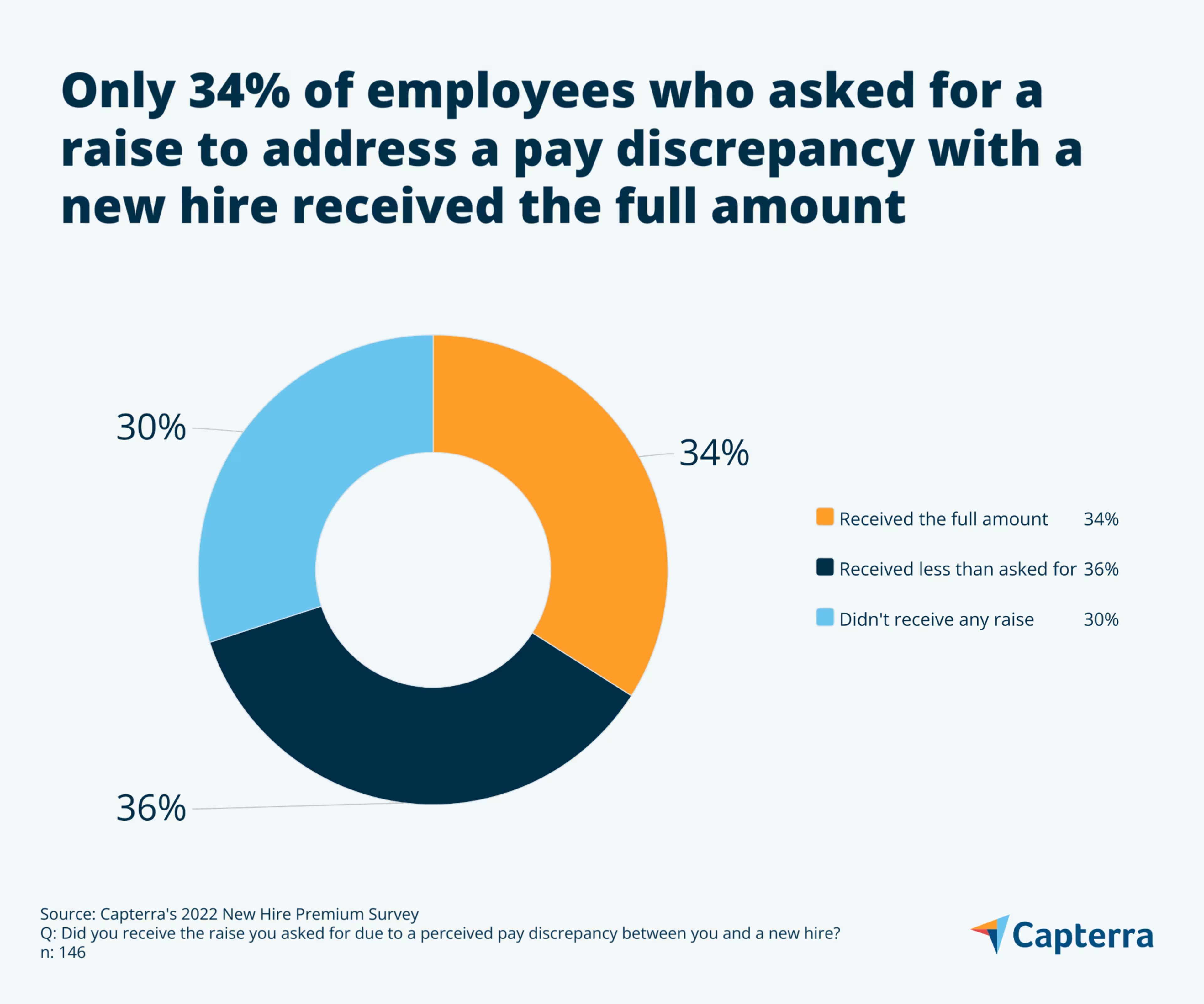
It’s understandable that employers don't want to give into every demand in this scenario. In some cases, the perceived pay discrepancy may not exist, the employee may be asking for more money than is reasonable, or employers may simply determine that the employee’s performance isn’t worth the full raise to address the discrepancy.
But with workers having all the leverage right now, the consequences of not giving employees satisfying responses regarding any pay discrepancies with new hires could be severe.
What you need to know: If you’re paying new hires more, the best solution to avoid conflict with current employees is to proactively audit employee compensation at least once a year (and more often in times of high inflation) to ensure there are no major discrepancies. If you do identify a discrepancy, determine a fair raise amount for the current employee, and let them know in generalized terms about the context for the increase.
See what users say are the top-ranked compensation management systems with Capterra Shortlist

3 strategies to end the vicious cycle of the new hire premium
For many companies, addressing every pay discrepancy caused by higher new hire pay isn't possible. The compensation budget simply won’t be there to support it. And when employees aren’t satisfied with their pay, they’re prepared to quit.
Not only do 68% of hiring managers in our survey say that at least one of their direct reports has asked for a raise or threatened to quit their job over a pay discrepancy with a new hire in the past 12 months, but 66% of employees also tell us they’ve at least considered looking for a new job in the past 12 months because they believe they could make more money elsewhere.
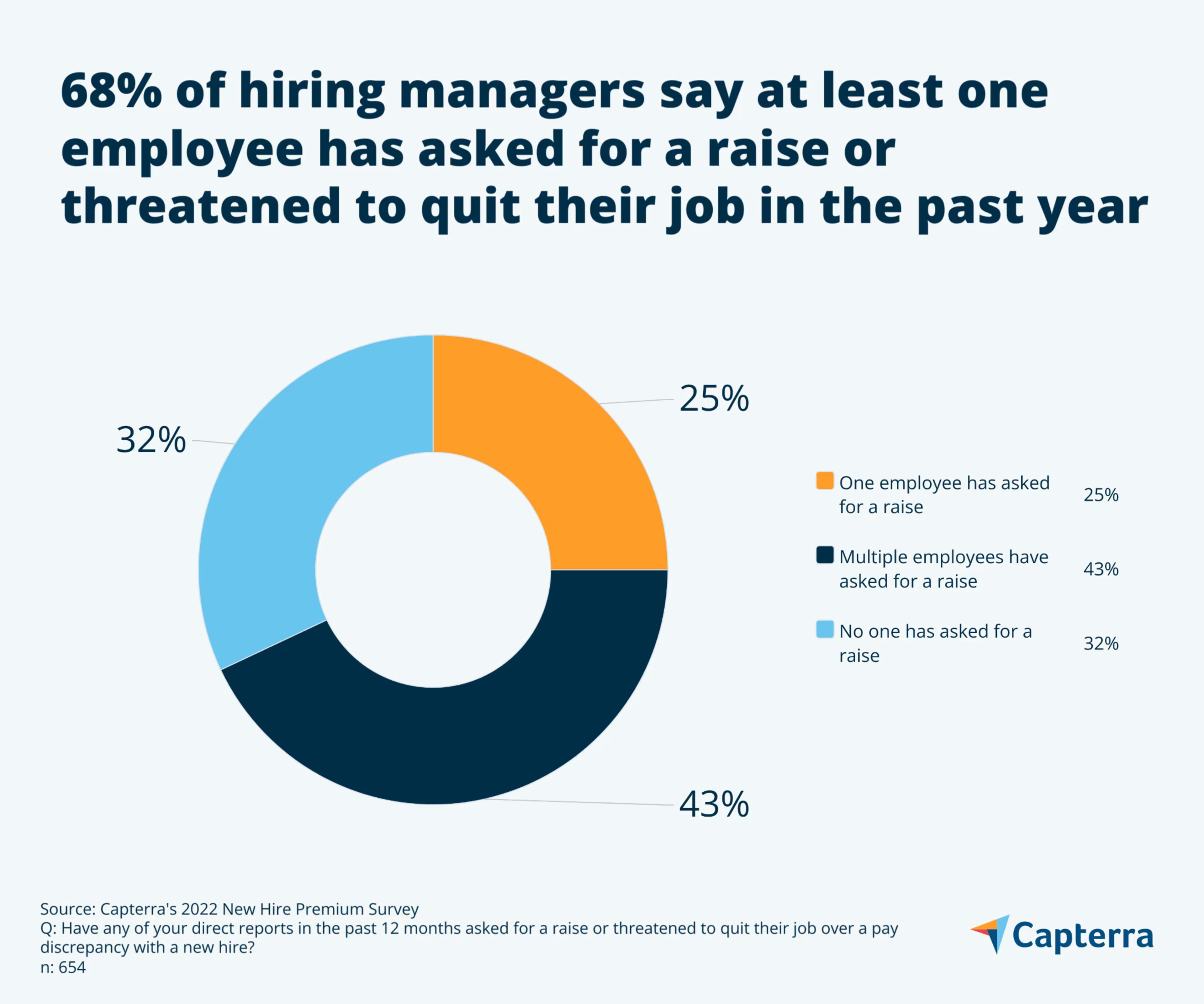
So starts a vicious cycle: Companies are having to pay new hires more, causing pay discrepancies with current employees. Those current employees learn of the discrepancy, but don’t always get the raise they want to address it. Finally, those employees quit to go somewhere else that is offering new hires more money—starting the whole conflict all over again.
If you can’t fully address every pay discrepancy with a new hire, here are three alternatives:
1. Reward tenure in other ways
If you can’t reward tenure with higher pay, you can reward it with other perks and benefits instead. Whether it’s more PTO, a clear progression path to a promotion, or giving employees discounted stock options that vest after a period of time, there are a number of other ways to tell employees it’s worth it to stick around.
2. Have solid data behind pay decisions
Employees may not like that they’re making less than a new hire, but they will hopefully at least understand why and be less likely to quit if you can provide data-backed rationale. Point to performance numbers, a difference in certifications and skill sets, or even the local cost of living if you have remote employees that reside in other areas.
3. Wait it out
Though the job market remains red hot, signs are growing that the economy is heading for a recession. When that happens—and companies cut back on hiring—not only will new hire pay settle back down, but current employees won’t have as much opportunity to seek out better compensation elsewhere. If you can be patient, the power in salary negotiations should eventually tip back in your company’s favor.
If you liked this report, check out more of Capterra’s latest talent management research:
